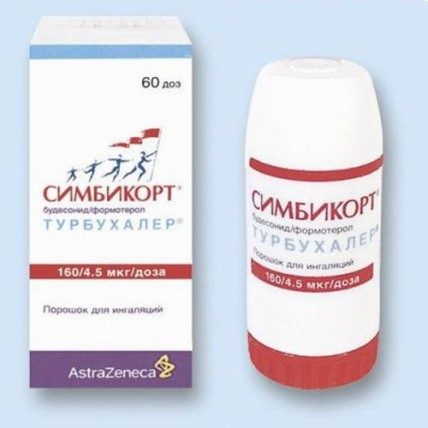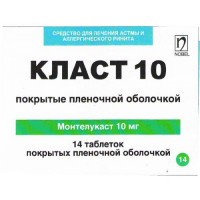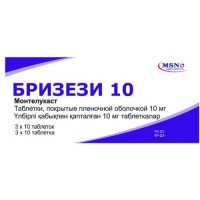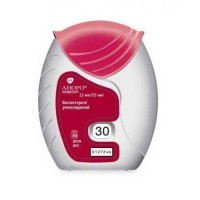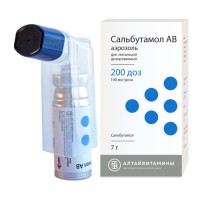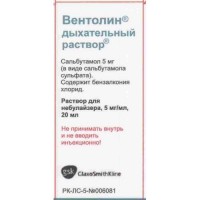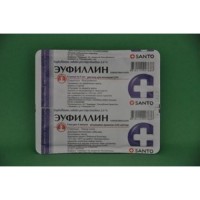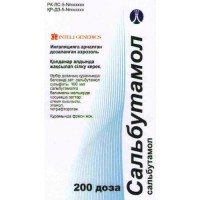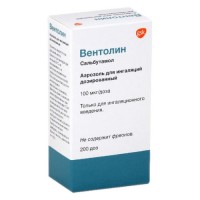Symbicort Turbuhaler 160 / 4.5 mcg 60 doses metered powder for inhalation
- $93.40
Sku:
658fd774c36b
Brand:
AstraZeneca (Sweden)
The instruction for use of medicine for experts
Symbicort Turbuhaler
the Trade name
Symbicort Turbuhaler
Mezhdunarodnoye the unlicensed name
Is absent
the Dosage form
Powder for inhalations dosed, 80/4.5 mkg / a dose and 160/4.5 mkg / a dose, on 60 doses and 120 dosed
Structure Each dose (the dose leaving a mouthpiece) contains active agents: budesonida of 80 mkg and formoterol of the fumarat of a dihydrate of 4.5 mkg, or budesonida of 160 mkg and formoterol of the fumarat of a dihydrate of 4.5 mkg.
excipient: lactoses monohydrate.
Description
Inhaler: the rotating doser of red color on which Braille's code is squeezed out. Cover of white color. In a window of the indicator of dosing figure 60 or 120 is visible to an inhaler on 60 doses or 120 doses, respectively. The mouthpiece can rotate.
Contents: granules from white till almost white color, mainly rounded shape.
Pharmacotherapeutic group
Other inhalation drugs for treatment of obstructive respiratory diseases.
ATH code: R03BX
The pharmacological
Pharmacokinetics Absorption Inhalated properties budesonid it is quickly absorbed and reaches the maximum concentration in plasma in 30 minutes after performing inhalation. The average dose of the budesonid which got into lungs after performing inhalation through Turbuhaler makes 32-44% of the delivered dose. The system bioavailability is about 49% of the delivered dose. At children aged from 6 up to 16 years the average dose of the budesonid which got into lungs after performing inhalation through Turbuhaler does not differ from indicators at adult patients.
Inhalated formoterol quickly it is absorbed and reaches the maximum concentration in blood plasma in 10 minutes after performing inhalation. The average dose of the formoterol which got into lungs after performing inhalation through Turbuhaler makes 28-49% of the delivered dose. The system bioavailability is about 61% of the delivered dose.
Distribution and metabolism
contacts proteins of plasma about 50% of a formoterol and 90% of a budesonid. Distribution volume for a formoterol is about 4 l/kg and for a budesonid - 3 l/kg. Formoterol is inactivated by conjugation (are formed active O-demetilirovannye metabolites generally in the form of the inactivated conjugates). Budesonid is exposed to intensive biotransformation (about 90%) at the first passing through a liver with formation of the metabolites having low glucocorticosteroid activity. The glucocorticosteroid activity of the main metabolites 6-b-hydroksibudesonida and 16-a-hydroxyprednisolonum does not exceed 1% of similar activity of a budesonid. There are no proofs of interaction of metabolites or substitution reaction between budesonidy and formoteroly. Budesonid is metabolized mainly with CYP3A4 enzyme participation. Metabolites of a budesonid are removed by kidneys in not changed look or in the form of conjugates. In urine only the insignificant quantity of not changed budesonid is found. Budesonid has high system clearance (about 1.2 l/min): time of semi-removal of drug in plasma, after intravenous administration, averages 4 hours.
The main part of a dose of a formoterol is exposed to metabolism in a liver and then is removed by kidneys: after inhalation of 8-13% of the delivered dose of a formoterol it is removed in not changed look. Formoterol has high system clearance (about 1.4 l/min): elimination half-life of drug averages 17 hours.
The pharmacokinetics of a formoterol and budesonid at patients with a renal failure is not studied. Concentration of a budesonid and formoterol in blood plasma can increase at patients with liver diseases.
The pharmacodynamics
Symbicort Turbuhaler contains formoterol and budesonid which have different mechanisms of action and show additive effect concerning decrease in frequency of exacerbations of bronchial asthma. Special characteristics of a budesonid and formoterol give the chance to use their combination at the same time as maintenance therapy and for stopping of attacks.
Budesonid - a glucocorticosteroid which after inhalation has fast and dose-dependent anti-inflammatory effect on airways, reducing expressiveness of symptoms and frequency of exacerbations of bronchial asthma. Budesonid reduces severity of hypostasis mucous bronchial tubes, products of slime, formation of a phlegm and hyperreactivity of airways. When assigning an inhalation budesonid the smaller frequency of emergence of serious undesirable effects is noted, than when using system glucocorticosteroids.
Formoterol - selection agonist of b2-adrenergic receptors after which inhalation there is a fast and long relaxation of smooth muscles of bronchial tubes at patients to reversible obstruction of airways. The dose-dependent broncholitic effect occurs within 1-3 minutes after inhalation and remains within at least 12 hours after reception of a single dose. Budesonid + Formoterol Bronchial asthma Clinical performance of Simbikort as maintenance therapy. Addition of a formoterol to a budesonid reduces expressiveness of symptoms of bronchial asthma, improves function of lungs and reduces the frequency of exacerbations of a disease.
Improvement of pulmonary function and good tolerance of therapy in comparison with the corresponding dose of a budesonid of Turbukhaler were noted.
Clinical performance of Simbikort for stopping of attacks.
After Simbikort's inhalations the stopping of symptoms (removal of a bronchospasm) comes also quickly and effectively, as after prescribing of salbutamol and a formoterol.
Chronic Obstructive Pulmonary Disease (COPD). At patients from heavy HOBL against the background of Simbikort Turbukhaler's reception the considerable decrease in frequency of exacerbations of a disease in comparison with the patients receiving as therapy only formoterol or placebo was observed.
Indications
- as maintenance therapy and for stopping of attacks in bronchial asthma.
- symptomatic therapy at patients with a heavy chronic obstructive pulmonary disease and with the repeating aggravations, despite therapy by bronchodilators of long action.
The route of administration and doses
Bronchial asthma
Exist two approaches to purpose of therapy by Simbikort Turbukhaler:
A. Simbikort Turbukhaler is appointed for continuous maintenance therapy in a combination with a separate b2-adrenostimulyator of short action for stopping of attacks.
V. Simbikort Turbukhaler is appointed both for continuous maintenance therapy, and at emergence of symptoms for stopping of attacks.
A. Simbikort Turbukhaler for maintenance therapy.
For stopping of attacks the patient needs to have constantly at himself a separate inhaler with a b2-adrenostimulyator of short action.
Adults (18 years are also more senior): Simbikort Turbukhaler of 80/4.5 mkg / dose and 160/4.5 mkg / dose: 1-2 inhalations two times a day. If necessary increase in a dose up to 4 inhalations two times a day is possible.
Teenagers (12-17 years): Simbikort Turbukhaler of 80/4.5 mkg / dose and 160/4.5 mkg / dose: 1-2 inhalations two times a day.
Children are more senior than 6 years: Simbikort Turbukhaler of 80/4.5 mkg / dose: 1-2 inhalations two times a day.
After achievement of optimum control over symptoms of bronchial asthma at administration of drug two times a day, are recommended to reduce a dose to minimum effective, up to administration of drug once a day when, according to the doctor, the patient needs maintenance therapy in a combination with a bronkhodilyatator of long action. Increase in frequency of use of b2-adrenostimulyator of short action is an indicator of deterioration in the general control over a disease and demands revision of antiasthmatic therapy.
Century. Simbikort Turbukhaler for maintenance therapy and for stopping of attacks
Simbikort Turbukhaler can be appointed both as continuous maintenance therapy, and as therapy on demand at emergence of attacks. The patient needs to have constantly at himself Simbikort Turbukhaler for stopping of attacks.
Simbikort Turbukhaler as maintenance therapy and for stopping of attacks is especially shown to patients with:
- insufficient control of bronchial asthma and need for frequent use of drugs for stopping of attacks,
- existence in the anamnesis of the exacerbations of bronchial asthma demanding medical intervention.
Careful control of dose-dependent side effects is required from the patients using a large number of inhalations for stopping of attacks.
Adults (18 years are also more senior): Simbikort Turbukhaler of 80/4.5 mkg / a dose and 160/4.5 mkg / a dose is recommended for maintenance therapy on 2 inhalations a day: on 1 inhalation in the morning and in the evening or on 2 inhalations once only in the morning or only in the evening. For some patients the maintenance dose of the drug Simbikort Turbukhaler of 160/4.5 mkg / a dose 2 inhalations two times a day can be appointed. At emergence of symptoms the purpose of 1 additional inhalation is necessary. At further increase of symptoms within several minutes 1 more additional inhalation, but no more than 6 inhalations for stopping of 1 attack is appointed.
Usually appointment more than 8 inhalations a day is not required, however it is possible to increase number of inhalations up to 12 in day by short time. It is recommended to the patients receiving more than 8 inhalations a day to ask for medical care for therapy revision.
Children and teenagers up to 18 years: Simbikort Turbukhaler for maintenance therapy and for stopping of attacks is not recommended to children and teenagers up to 18 years.
Chronic obstructive pulmonary disease Adults: 2 inhalations of Simbikort Turbukhaler of 160/4.5 mkg / a dose two times a day.
Special groups of patients: there is no need for special selection of a dose of drug for patients of advanced age. There are no data on the Simbikort's reception by patients with a renal or liver failure. As budesonid and formoterol are mainly removed with the participation of hepatic metabolism, at patients with heavy cirrhosis it is possible to expect delay of clearance rate of drug.
Children up to 6 years:
Simbikort Turbukhaler is not recommended to children up to 6 years.
It is necessary for the correct use of Simbikort Turbukhaler:
- to attentively study the instruction for use of Turbukhaler
- to inhale strongly and deeply through a mouthpiece to guarantee hit of an optimum dose of drug in lungs
- never to exhale through a mouthpiece
- to rinse a mouth water after inhalations as maintenance doses, and for stopping of symptoms for reduction of risk of development of candidiasis of a mucous membrane of a mouth and throat.
The patient can not feel taste or not feel drug after Simbikotr Turbukhaler's use that is caused by a small amount of the delivered substance.
Side effect
the Most frequent side reactions connected with administration of drug are such pharmacological expected phenomena, undesirable to b2-adrenomimetik, as a tremor and a cardiopalmus. Symptoms usually have moderate degree of manifestation and pass in several days after an initiation of treatment.
Often (& gt, 1/100, & lt, 1/10):
- a headache
- heartbeat
- a tremor
- candidiases of a mucous membrane of a mouth and throat, cough, a hoarseness, slight irritation in a throat
is Less frequent (& gt, 1/1000, & lt, 1/100)
- tachycardia
- muscular spasms
- psychomotor excitement, concern, nausea, dizziness, sleep disorders
- bruises
Seldom (& gt, 1/10000, & lt, 1/1000)
- a dieback, urticaria, an itching dermatitis, an angioedema
- a bronchospasm
- a hypopotassemia
- fibrillation of auricles, supraventricular tachycardia, premature ventricular contraction
Is very rare (& lt, 1/10000)
- a hyperglycemia, signs or symptoms of system glyukokorotkosteroidny effects (including a hypoadrenalism)
- a depression, behavior disorders (mainly at children)
- disturbances of taste
- stenocardia, fluctuations of arterial blood pressure
of the Contraindication
- hypersensitivity to a budesonid, a formoterol or the inhalated lactose
- children's age up to 6 years.
Medicinal interactions
Reception of 200 mg of a ketokonazol increases concentration in plasma of an oral budesonid (single dose of 3 mg) at their joint appointment, on average, by 6 times once a day. When assigning a ketokonazol in 12 hours after reception of a budesonid, concentration in plasma of the last increased, on average, by 3 times. Information on similar interaction with an inhalation budesonid is absent, however, it is necessary to expect noticeable increase in concentration of drug in blood plasma. Therefore it is necessary to avoid the above combination of drugs. If it is impossible, the time interval between purpose of a ketokonazol and budesonid should be increased as much as possible. Also it is necessary to consider the possibility of a dose decline of a budesonid. Other powerful CYP3A4 inhibitors probably can also increase considerably concentration of a budesonid in plasma. Simbikort Turbukhaler's appointment as maintenance therapy and for stopping of attacks is not recommended to the patients receiving powerful CYP3A4 inhibitors.
Blockers of b-adrenergic receptors can weaken action of a formoterol. Simbikort it is not necessary to appoint along with b-adrenoblockers (including eye drops), except for the forced cases.
Joint appointment of Simbikort Turbukhaler and quinidine, Disopyramidum, procaineamide, fenotiazin, antihistaminic drugs (terfenadin), inhibitors of a monoaminooxidase (MAO) and tricyclic antidepressants can extend an interval of QTc and increase risk of developing of ventricular arrhythmias.
Besides, the levodopa, left thyroxine, oxytocin and alcohol can reduce tolerance of a cardiac muscle to b2-adrenomimetika.
Joint prescribing of MAO inhibitors and also the drugs having similar properties such as furasolidone and Procarbazinum, can cause increase in arterial blood pressure. There is an increased risk of developing arrhythmias at patients when carrying out the general anesthesia drugs of the halogenated hydrocarbons.
At joint reception of Simbikort Turbukhaler and other b-adrenergic medicines strengthening of side effect of a formoterol is possible.
The hypopotassemia which can amplify at the accompanying treatment by xanthine derivatives, mineral derivatives of glucocorticosteroids or diuretics can result from use of b2-adrenomimetik. The hypopotassemia can enhance predisposition to development of arrhythmias in the patients accepting cardiac glycosides.
Interaction of a budesonid with other medicines used for treatment of bronchial asthma was not noted.
The special
instructions Simbikort Turbukhaler it is not intended for initial treatment of bronchial asthma of an intermittent and easy persistent course. Simbikort Turbukhaler does not intend for initial selection of therapy at the first stages of treatment of bronchial asthma. Simbikort Turbukhaler of 80/4.5 mkg / a dose is not intended for patients with heavy bronchial asthma. Treatment by Simbikort Turbukhaler should not be begun during exacerbation of bronchial asthma.
Selection of a dose of the drugs which are Simbikort's part happens individually depending on severity of a disease. It needs to be considered not only in an initiation of treatment the combined drugs, but also at change of a maintenance dose of drug.
In case certain patients need other combination of doses of active components, than in Simbikort Turbukhaler, it is necessary to appoint b2-adrenomimetik and/or glucocorticosteroids in separate inhalers.
Simbikort Turbukhaler's dose should be lowered to the smallest against the background of which optimum control of symptoms of bronchial asthma is retained. Patients have to be under constant control of the doctor for adequate selection of a dose Simbikort Turbukhaler. At achievement of complete control over symptoms of bronchial asthma against the background of the minimum recommended dose of drug it is possible to try purpose of monotherapy by inhalation glucocorticosteroids.
At insufficient efficiency of therapy or exceeding the maximum recommended Simbikort's doses it is necessary to reconsider treatment tactics. The unexpected and progressing deterioration in control of symptoms of bronchial asthma or chronic obstructive pulmonary disease is the state which is potentially menacing for life and demands urgent medical intervention. In this situation it is necessary to consider the possibility of increase in a dose of glucocorticosteroids, i.e. purpose of a course of oral glucocorticosteroids or treatment by antibiotics in case of accession of an infection. Patients are recommended to have constantly at themselves drugs of emergency aid or Simbikort Turbukhaler (for the patients with bronchial asthma using Simbikort Turbukhaler for maintenance therapy and for stopping of attacks), or the b2nd adrenomimetik of short action (for all patients using Simbikort Turbukhaler only for maintenance therapy).
It is necessary to draw the attention of the patient to need of regular reception of a maintenance dose Simbikort Turbukhaler according to the picked-up therapy, even in cases of lack of symptoms of a disease. Simbikort Turbukhaler's inhalations for stopping of attacks have to be carried out only at emergence of symptoms, but are not shown for regular preventive use, i.e. before physical activity. In such cases the use of a separate bronkhodilyatator of short action is shown.
It is recommended to reduce gradually a drug dose before the termination of treatment and it is not recommended to cancel treatment sharply.
As well as at any other inhalation therapy, emergence of a paradoxical bronchospasm with immediate strengthening of rattles after reception of a dose of drug is possible. In this connection, it is necessary to stop therapy by Simbikort, to reconsider tactics of treatment and, if necessary, to appoint alternative therapy.
Systemic action can be shown at reception of any inhalation glucocorticosteroids, especially at reception of high doses of drugs during the long span. Suppression of function of adrenal glands, a growth inhibition at children and teenagers, decrease in bone mineral density, a cataract and glaucoma belong to possible system effects.
It is regularly recommended to monitorirovat growth of children, it is long receiving glucocorticosteroid therapy in the inhalated form. In case of the established growth inhibition, it is necessary to reconsider therapy for the purpose of a dose decline of the inhalated glucocorticosteroid. It is necessary to estimate carefully a ratio of advantage of glucocorticosteroid therapy and possible risk of a growth inhibition. When choosing therapy it is recommended to address the children's pulmonologist.
Because of potentially possible action of inhalation glucocorticosteroids on bone mineral density it is necessary to pay special attention to the patients accepting high doses of drug during the long period with presence of risk factors of developing osteoporosis. Researches of prolonged use of the inhalated budesonid at children in an average daily dose of 400 mkg (the measured dose) or adults in a daily dose of 800 mkg (the measured dose) did not show noticeable action on bone mineral density. There are no data on action of high doses of Simbikort Turbukhaler on bone mineral density.
If there are bases to believe that against the background of the previous system therapy the glucocorticosteroids broke function of adrenal glands, it is necessary to take precautionary measures at transfer of patients to treatment by Simbikort.
At the patients stopping therapy by oral glucocorticosteroids the insufficient function of adrenal glands can remain for a long time. Patients who in the past needed urgent reception of high doses of glucocorticosteroids or received long-term treatment by inhalation glucocorticosteroids in a high dose can also be in this risk group. It is necessary to provide additional purpose of glucocorticosteroids in the period of a stress or surgical intervention.
It is recommended to instruct the patient about need to rinse a mouth water after inhalations of maintenance doses and for stopping of symptoms for the purpose of prevention of risk of developing candidiasis of a mucous membrane of a mouth and throat and also in case of development of candidiasis of a mucous membrane of a mouth and throat.
It is necessary to observe precautionary measures at treatment of patients with the extended QTs-interval. Reception of a formoterol can cause lengthening of QTs-of an interval.
It is necessary to reconsider need of use and a dose of the inhalated glucocorticosteroid at patients with active or inactive forms of a pulmonary tuberculosis, fungal, viral or bacterial infections of respiratory organs.
At joint purpose of b2-adrenomimetik with drugs which can cause or enhance gipokaliyemichesky effect, for example, xanthine derivatives, steroids or diuretics, strengthening of gipokaliyemichesky effect of b2-adrenomimetik is possible. It is necessary to observe special precautionary measures at the patients with unstable bronchial asthma applying bronkhodilyatator of short action for removal of attacks at exacerbation of heavy bronchial asthma as risk of development of a hypopotassemia increases against the background of a hypoxia and at other states when the probability of manifestation of development of gipokaliyemichesky effect increases. In such cases it is recommended to control potassium content in serum.
Reception by patients with acute bronchial obstruction of a formoterol in a dose of 90 mkg within 3 hours is safe. During treatment it is necessary to control concentration of glucose in blood at the patients having diabetes.
Simbikort Turbukhaler contains lactose (& lt, 1 mg / inhalation). Usually such quantity does not cause problems in patients with a lactose intolerance.
With care:
A pulmonary tuberculosis (active or inactive form), fungal, viral or bacterial infections of respiratory organs, a thyrotoxicosis, a pheochromocytoma, diabetes, an uncontrollable hypopotassemia, an idiopathic hypertrophic subaortal stenosis, heavy arterial hypertension, aneurysm of any localization or other serious cardiovascular illness (coronary heart disease, a tachyarrhythmia or heart failure of heavy degree), lengthening of an interval of QT (reception of a formoterol can cause lengthening of QTs-of an interval).
Pregnancy and a lactation
Are not present clinical data on Simbikort Turbukhaler's use or sharing of a formoterol and a budesonid during pregnancy.
During pregnancy Simbikort it is necessary to use only when the advantage of use of drug exceeds potential risk for a fruit. It is necessary to use the smallest effective dose of a budesonid necessary for maintenance of adequate control of symptoms of bronchial asthma. It is unknown whether gets formoterol or budesonid into breast milk of women. Simbikort Turbukhaler can be appointed to the feeding women, only if the expected advantage for mother is more, than any possible risk for the child.
The feature of influence of medicine on ability to run the vehicle or potentially dangerous
Simbikort Turbukhaler mechanisms does not influence ability to drive and operate mechanisms. But it can influence ability to drive and operate mechanisms in case of development of side effect.
Overdose
Symptoms of overdose of a formoterol: tremor, headache, cardiopalmus. It was in some cases reported about development of tachycardia, a hyperglycemia, hypopotassemia, lengthening of a QTs-interval, arrhythmia, nausea and vomiting. The supporting and symptomatic treatment can be appointed.
In case of need Simbikort Turbukhaler's cancellations owing to overdose of the formoterol which is a part of the combined drug it is necessary to consider a question of purpose of the corresponding glucocorticosteroid.
At acute overdose of a budesonid, even in considerable doses, clinically significant effects are not expected. At chronic reception of overdoses the systemic action of glucocorticosteroids, such as hypercorticoidism and suppression of function of adrenal glands can be shown.
A form of release and packing
Powder for inhalations dosed 80/4.5 mkg / a dose and 160/4.5 mkg / a dose. On 60 doses and 120 doses in the plastic inhaler consisting of the portioning device, a vessel for storage of powder, a vessel for a desiccant, a mouthpiece and the screw-on cover. Each inhaler is located in a cardboard pack from instructions for use.
Storage conditions
At a temperature are lower + 30C. To store in places inaccessible for children!
2 years not to apply an expiration date after the expiration date specified on packing.
Prescription status According to the prescription
the Name and the address
of the producer AstraZenek of AB, S-151 85 Sodertalje, Sweden
Simbikort and Turbukhaler the trademark - the property of the company of AstraZenek.
AstraZeneca of 2005-2006.
Additional information is provided on demand:
Moscow 119992 Timur Frunze St. 11 building 2-5
ph. 495 799 56 99, fax. 495 799 56 98
RU/RITA.000-017,678.3.0.
USE TURBUKHALERA
Turbukhaler the multidose inhaler allowing to dose and inhale drug in very small doses (rice 1). When you take a breath, powder from Turbukhaler is delivered in lungs. Therefore it is important that you strongly and deeply inhaled through a mouthpiece.
Turbukhaler's training for the first use:
Before the first use of Turbukhaler it needs to be prepared for work:
1. Unscrew and remove a cap.
2. You hold an inhaler vertically red doser (fig. 2) down. You do not hold an inhaler for a mouthpiece when you turn the doser. Turn the doser against the stop in one direction, and then also against the stop in an opposite direction. Perform the described procedure twice.
Now the inhaler is ready to use and you should not repeat this procedure of training of Turbukhaler for work before each use. To take the drug, follow the instruction given below.
How to use СИМБИКОРТÒ, ТУРБУХАЛЕРÒ,
For reception of one dose follow the procedure described below.
1. Unscrew and remove a cap.
2. You hold an inhaler vertically red doser (fig. 2) down. You do not hold an inhaler for a mouthpiece when you turn the doser. To measure a dose, turn the doser against the stop in one direction, and then also against the stop in an opposite direction.
3. Exhale. Do not exhale through a mouthpiece.
4. Carefully place a mouthpiece between teeth, squeeze lips and inhale strongly and deeply through a mouth (fig. 3). Not to chew and not to squeeze a mouthpiece teeth.
5. Before exhaling, take out an inhaler from a mouth.
6. If inhalation more is required than one dose, repeat steps 2-5.
7. Close an inhaler a cap, check that the cap of an inhaler was screwed carefully up.
8. Rinse a mouth water, without swallowing.
IMPORTANT!
Do not try to remove a mouthpiece as it is fixed on an inhaler and does not act. The mouthpiece of a turbukhaler rotates, but do not turn it needlessly.
As the amount of the inhaled powder is not enough, you, perhaps, will not feel taste of powder after inhalation.
However, if you followed the instruction, then can be sure that you inhaled (inhalated) a necessary dose of drug.
If you before drug acceptance by mistake repeated the procedure for loading of an inhaler more than once, at inhalation all of you equally receive one dose of drug while the indicator of doses will show total measured the dosed
Sound which you hear, stirring up an inhaler, is made by the draining agent, but not medicine.
How to learn when the inhaler has to be replaced?
The indicator of doses (fig. 4) shows approximate quantity of the doses which remained in an inhaler, doses of the filled Turbukhaler are reckoned from the 60th or 120th dose (depending on total number of doses of Turbukhaler acquired by you).
The indicator shows an interval of 10 doses therefore it does not show each measured (loaded) dose.
You can be sure that Turbukhaler delivers a necessary dose of drug even if you do not notice change in an indicator window dosed
Emergence of a red background in a window of the indicator of doses means that in Turbukhaler there were 10 doses of drug. At emergence of figure 0 on a red background in the middle of a window of doses an inhaler (fig. 5) the inhaler has to be thrown out.
Notice that even when the window of the indicator of doses shows figure 0, the doser continues to turn. However the indicator of doses stops fixing quantity of doses (sticks to move) and in a window of doses of an inhaler there is figure 0.
Cleaning
Regularly (once a week) clean a mouthpiece outside with dry fabric.
Do not use water or other liquids for cleaning of a mouthpiece.
Utilization
Be careful with the used inhaler, you remember that in an inhaler there can be a number of drug.
To develop
Symbicort Turbuhaler
the Trade name
Symbicort Turbuhaler
Mezhdunarodnoye the unlicensed name
Is absent
the Dosage form
Powder for inhalations dosed, 80/4.5 mkg / a dose and 160/4.5 mkg / a dose, on 60 doses and 120 dosed
Structure Each dose (the dose leaving a mouthpiece) contains active agents: budesonida of 80 mkg and formoterol of the fumarat of a dihydrate of 4.5 mkg, or budesonida of 160 mkg and formoterol of the fumarat of a dihydrate of 4.5 mkg.
excipient: lactoses monohydrate.
Description
Inhaler: the rotating doser of red color on which Braille's code is squeezed out. Cover of white color. In a window of the indicator of dosing figure 60 or 120 is visible to an inhaler on 60 doses or 120 doses, respectively. The mouthpiece can rotate.
Contents: granules from white till almost white color, mainly rounded shape.
Pharmacotherapeutic group
Other inhalation drugs for treatment of obstructive respiratory diseases.
ATH code: R03BX
The pharmacological
Pharmacokinetics Absorption Inhalated properties budesonid it is quickly absorbed and reaches the maximum concentration in plasma in 30 minutes after performing inhalation. The average dose of the budesonid which got into lungs after performing inhalation through Turbuhaler makes 32-44% of the delivered dose. The system bioavailability is about 49% of the delivered dose. At children aged from 6 up to 16 years the average dose of the budesonid which got into lungs after performing inhalation through Turbuhaler does not differ from indicators at adult patients.
Inhalated formoterol quickly it is absorbed and reaches the maximum concentration in blood plasma in 10 minutes after performing inhalation. The average dose of the formoterol which got into lungs after performing inhalation through Turbuhaler makes 28-49% of the delivered dose. The system bioavailability is about 61% of the delivered dose.
Distribution and metabolism
contacts proteins of plasma about 50% of a formoterol and 90% of a budesonid. Distribution volume for a formoterol is about 4 l/kg and for a budesonid - 3 l/kg. Formoterol is inactivated by conjugation (are formed active O-demetilirovannye metabolites generally in the form of the inactivated conjugates). Budesonid is exposed to intensive biotransformation (about 90%) at the first passing through a liver with formation of the metabolites having low glucocorticosteroid activity. The glucocorticosteroid activity of the main metabolites 6-b-hydroksibudesonida and 16-a-hydroxyprednisolonum does not exceed 1% of similar activity of a budesonid. There are no proofs of interaction of metabolites or substitution reaction between budesonidy and formoteroly. Budesonid is metabolized mainly with CYP3A4 enzyme participation. Metabolites of a budesonid are removed by kidneys in not changed look or in the form of conjugates. In urine only the insignificant quantity of not changed budesonid is found. Budesonid has high system clearance (about 1.2 l/min): time of semi-removal of drug in plasma, after intravenous administration, averages 4 hours.
The main part of a dose of a formoterol is exposed to metabolism in a liver and then is removed by kidneys: after inhalation of 8-13% of the delivered dose of a formoterol it is removed in not changed look. Formoterol has high system clearance (about 1.4 l/min): elimination half-life of drug averages 17 hours.
The pharmacokinetics of a formoterol and budesonid at patients with a renal failure is not studied. Concentration of a budesonid and formoterol in blood plasma can increase at patients with liver diseases.
The pharmacodynamics
Symbicort Turbuhaler contains formoterol and budesonid which have different mechanisms of action and show additive effect concerning decrease in frequency of exacerbations of bronchial asthma. Special characteristics of a budesonid and formoterol give the chance to use their combination at the same time as maintenance therapy and for stopping of attacks.
Budesonid - a glucocorticosteroid which after inhalation has fast and dose-dependent anti-inflammatory effect on airways, reducing expressiveness of symptoms and frequency of exacerbations of bronchial asthma. Budesonid reduces severity of hypostasis mucous bronchial tubes, products of slime, formation of a phlegm and hyperreactivity of airways. When assigning an inhalation budesonid the smaller frequency of emergence of serious undesirable effects is noted, than when using system glucocorticosteroids.
Formoterol - selection agonist of b2-adrenergic receptors after which inhalation there is a fast and long relaxation of smooth muscles of bronchial tubes at patients to reversible obstruction of airways. The dose-dependent broncholitic effect occurs within 1-3 minutes after inhalation and remains within at least 12 hours after reception of a single dose. Budesonid + Formoterol Bronchial asthma Clinical performance of Simbikort as maintenance therapy. Addition of a formoterol to a budesonid reduces expressiveness of symptoms of bronchial asthma, improves function of lungs and reduces the frequency of exacerbations of a disease.
Improvement of pulmonary function and good tolerance of therapy in comparison with the corresponding dose of a budesonid of Turbukhaler were noted.
Clinical performance of Simbikort for stopping of attacks.
After Simbikort's inhalations the stopping of symptoms (removal of a bronchospasm) comes also quickly and effectively, as after prescribing of salbutamol and a formoterol.
Chronic Obstructive Pulmonary Disease (COPD). At patients from heavy HOBL against the background of Simbikort Turbukhaler's reception the considerable decrease in frequency of exacerbations of a disease in comparison with the patients receiving as therapy only formoterol or placebo was observed.
Indications
- as maintenance therapy and for stopping of attacks in bronchial asthma.
- symptomatic therapy at patients with a heavy chronic obstructive pulmonary disease and with the repeating aggravations, despite therapy by bronchodilators of long action.
The route of administration and doses
Bronchial asthma
Exist two approaches to purpose of therapy by Simbikort Turbukhaler:
A. Simbikort Turbukhaler is appointed for continuous maintenance therapy in a combination with a separate b2-adrenostimulyator of short action for stopping of attacks.
V. Simbikort Turbukhaler is appointed both for continuous maintenance therapy, and at emergence of symptoms for stopping of attacks.
A. Simbikort Turbukhaler for maintenance therapy.
For stopping of attacks the patient needs to have constantly at himself a separate inhaler with a b2-adrenostimulyator of short action.
Adults (18 years are also more senior): Simbikort Turbukhaler of 80/4.5 mkg / dose and 160/4.5 mkg / dose: 1-2 inhalations two times a day. If necessary increase in a dose up to 4 inhalations two times a day is possible.
Teenagers (12-17 years): Simbikort Turbukhaler of 80/4.5 mkg / dose and 160/4.5 mkg / dose: 1-2 inhalations two times a day.
Children are more senior than 6 years: Simbikort Turbukhaler of 80/4.5 mkg / dose: 1-2 inhalations two times a day.
After achievement of optimum control over symptoms of bronchial asthma at administration of drug two times a day, are recommended to reduce a dose to minimum effective, up to administration of drug once a day when, according to the doctor, the patient needs maintenance therapy in a combination with a bronkhodilyatator of long action. Increase in frequency of use of b2-adrenostimulyator of short action is an indicator of deterioration in the general control over a disease and demands revision of antiasthmatic therapy.
Century. Simbikort Turbukhaler for maintenance therapy and for stopping of attacks
Simbikort Turbukhaler can be appointed both as continuous maintenance therapy, and as therapy on demand at emergence of attacks. The patient needs to have constantly at himself Simbikort Turbukhaler for stopping of attacks.
Simbikort Turbukhaler as maintenance therapy and for stopping of attacks is especially shown to patients with:
- insufficient control of bronchial asthma and need for frequent use of drugs for stopping of attacks,
- existence in the anamnesis of the exacerbations of bronchial asthma demanding medical intervention.
Careful control of dose-dependent side effects is required from the patients using a large number of inhalations for stopping of attacks.
Adults (18 years are also more senior): Simbikort Turbukhaler of 80/4.5 mkg / a dose and 160/4.5 mkg / a dose is recommended for maintenance therapy on 2 inhalations a day: on 1 inhalation in the morning and in the evening or on 2 inhalations once only in the morning or only in the evening. For some patients the maintenance dose of the drug Simbikort Turbukhaler of 160/4.5 mkg / a dose 2 inhalations two times a day can be appointed. At emergence of symptoms the purpose of 1 additional inhalation is necessary. At further increase of symptoms within several minutes 1 more additional inhalation, but no more than 6 inhalations for stopping of 1 attack is appointed.
Usually appointment more than 8 inhalations a day is not required, however it is possible to increase number of inhalations up to 12 in day by short time. It is recommended to the patients receiving more than 8 inhalations a day to ask for medical care for therapy revision.
Children and teenagers up to 18 years: Simbikort Turbukhaler for maintenance therapy and for stopping of attacks is not recommended to children and teenagers up to 18 years.
Chronic obstructive pulmonary disease Adults: 2 inhalations of Simbikort Turbukhaler of 160/4.5 mkg / a dose two times a day.
Special groups of patients: there is no need for special selection of a dose of drug for patients of advanced age. There are no data on the Simbikort's reception by patients with a renal or liver failure. As budesonid and formoterol are mainly removed with the participation of hepatic metabolism, at patients with heavy cirrhosis it is possible to expect delay of clearance rate of drug.
Children up to 6 years:
Simbikort Turbukhaler is not recommended to children up to 6 years.
It is necessary for the correct use of Simbikort Turbukhaler:
- to attentively study the instruction for use of Turbukhaler
- to inhale strongly and deeply through a mouthpiece to guarantee hit of an optimum dose of drug in lungs
- never to exhale through a mouthpiece
- to rinse a mouth water after inhalations as maintenance doses, and for stopping of symptoms for reduction of risk of development of candidiasis of a mucous membrane of a mouth and throat.
The patient can not feel taste or not feel drug after Simbikotr Turbukhaler's use that is caused by a small amount of the delivered substance.
Side effect
the Most frequent side reactions connected with administration of drug are such pharmacological expected phenomena, undesirable to b2-adrenomimetik, as a tremor and a cardiopalmus. Symptoms usually have moderate degree of manifestation and pass in several days after an initiation of treatment.
Often (& gt, 1/100, & lt, 1/10):
- a headache
- heartbeat
- a tremor
- candidiases of a mucous membrane of a mouth and throat, cough, a hoarseness, slight irritation in a throat
is Less frequent (& gt, 1/1000, & lt, 1/100)
- tachycardia
- muscular spasms
- psychomotor excitement, concern, nausea, dizziness, sleep disorders
- bruises
Seldom (& gt, 1/10000, & lt, 1/1000)
- a dieback, urticaria, an itching dermatitis, an angioedema
- a bronchospasm
- a hypopotassemia
- fibrillation of auricles, supraventricular tachycardia, premature ventricular contraction
Is very rare (& lt, 1/10000)
- a hyperglycemia, signs or symptoms of system glyukokorotkosteroidny effects (including a hypoadrenalism)
- a depression, behavior disorders (mainly at children)
- disturbances of taste
- stenocardia, fluctuations of arterial blood pressure
of the Contraindication
- hypersensitivity to a budesonid, a formoterol or the inhalated lactose
- children's age up to 6 years.
Medicinal interactions
Reception of 200 mg of a ketokonazol increases concentration in plasma of an oral budesonid (single dose of 3 mg) at their joint appointment, on average, by 6 times once a day. When assigning a ketokonazol in 12 hours after reception of a budesonid, concentration in plasma of the last increased, on average, by 3 times. Information on similar interaction with an inhalation budesonid is absent, however, it is necessary to expect noticeable increase in concentration of drug in blood plasma. Therefore it is necessary to avoid the above combination of drugs. If it is impossible, the time interval between purpose of a ketokonazol and budesonid should be increased as much as possible. Also it is necessary to consider the possibility of a dose decline of a budesonid. Other powerful CYP3A4 inhibitors probably can also increase considerably concentration of a budesonid in plasma. Simbikort Turbukhaler's appointment as maintenance therapy and for stopping of attacks is not recommended to the patients receiving powerful CYP3A4 inhibitors.
Blockers of b-adrenergic receptors can weaken action of a formoterol. Simbikort it is not necessary to appoint along with b-adrenoblockers (including eye drops), except for the forced cases.
Joint appointment of Simbikort Turbukhaler and quinidine, Disopyramidum, procaineamide, fenotiazin, antihistaminic drugs (terfenadin), inhibitors of a monoaminooxidase (MAO) and tricyclic antidepressants can extend an interval of QTc and increase risk of developing of ventricular arrhythmias.
Besides, the levodopa, left thyroxine, oxytocin and alcohol can reduce tolerance of a cardiac muscle to b2-adrenomimetika.
Joint prescribing of MAO inhibitors and also the drugs having similar properties such as furasolidone and Procarbazinum, can cause increase in arterial blood pressure. There is an increased risk of developing arrhythmias at patients when carrying out the general anesthesia drugs of the halogenated hydrocarbons.
At joint reception of Simbikort Turbukhaler and other b-adrenergic medicines strengthening of side effect of a formoterol is possible.
The hypopotassemia which can amplify at the accompanying treatment by xanthine derivatives, mineral derivatives of glucocorticosteroids or diuretics can result from use of b2-adrenomimetik. The hypopotassemia can enhance predisposition to development of arrhythmias in the patients accepting cardiac glycosides.
Interaction of a budesonid with other medicines used for treatment of bronchial asthma was not noted.
The special
instructions Simbikort Turbukhaler it is not intended for initial treatment of bronchial asthma of an intermittent and easy persistent course. Simbikort Turbukhaler does not intend for initial selection of therapy at the first stages of treatment of bronchial asthma. Simbikort Turbukhaler of 80/4.5 mkg / a dose is not intended for patients with heavy bronchial asthma. Treatment by Simbikort Turbukhaler should not be begun during exacerbation of bronchial asthma.
Selection of a dose of the drugs which are Simbikort's part happens individually depending on severity of a disease. It needs to be considered not only in an initiation of treatment the combined drugs, but also at change of a maintenance dose of drug.
In case certain patients need other combination of doses of active components, than in Simbikort Turbukhaler, it is necessary to appoint b2-adrenomimetik and/or glucocorticosteroids in separate inhalers.
Simbikort Turbukhaler's dose should be lowered to the smallest against the background of which optimum control of symptoms of bronchial asthma is retained. Patients have to be under constant control of the doctor for adequate selection of a dose Simbikort Turbukhaler. At achievement of complete control over symptoms of bronchial asthma against the background of the minimum recommended dose of drug it is possible to try purpose of monotherapy by inhalation glucocorticosteroids.
At insufficient efficiency of therapy or exceeding the maximum recommended Simbikort's doses it is necessary to reconsider treatment tactics. The unexpected and progressing deterioration in control of symptoms of bronchial asthma or chronic obstructive pulmonary disease is the state which is potentially menacing for life and demands urgent medical intervention. In this situation it is necessary to consider the possibility of increase in a dose of glucocorticosteroids, i.e. purpose of a course of oral glucocorticosteroids or treatment by antibiotics in case of accession of an infection. Patients are recommended to have constantly at themselves drugs of emergency aid or Simbikort Turbukhaler (for the patients with bronchial asthma using Simbikort Turbukhaler for maintenance therapy and for stopping of attacks), or the b2nd adrenomimetik of short action (for all patients using Simbikort Turbukhaler only for maintenance therapy).
It is necessary to draw the attention of the patient to need of regular reception of a maintenance dose Simbikort Turbukhaler according to the picked-up therapy, even in cases of lack of symptoms of a disease. Simbikort Turbukhaler's inhalations for stopping of attacks have to be carried out only at emergence of symptoms, but are not shown for regular preventive use, i.e. before physical activity. In such cases the use of a separate bronkhodilyatator of short action is shown.
It is recommended to reduce gradually a drug dose before the termination of treatment and it is not recommended to cancel treatment sharply.
As well as at any other inhalation therapy, emergence of a paradoxical bronchospasm with immediate strengthening of rattles after reception of a dose of drug is possible. In this connection, it is necessary to stop therapy by Simbikort, to reconsider tactics of treatment and, if necessary, to appoint alternative therapy.
Systemic action can be shown at reception of any inhalation glucocorticosteroids, especially at reception of high doses of drugs during the long span. Suppression of function of adrenal glands, a growth inhibition at children and teenagers, decrease in bone mineral density, a cataract and glaucoma belong to possible system effects.
It is regularly recommended to monitorirovat growth of children, it is long receiving glucocorticosteroid therapy in the inhalated form. In case of the established growth inhibition, it is necessary to reconsider therapy for the purpose of a dose decline of the inhalated glucocorticosteroid. It is necessary to estimate carefully a ratio of advantage of glucocorticosteroid therapy and possible risk of a growth inhibition. When choosing therapy it is recommended to address the children's pulmonologist.
Because of potentially possible action of inhalation glucocorticosteroids on bone mineral density it is necessary to pay special attention to the patients accepting high doses of drug during the long period with presence of risk factors of developing osteoporosis. Researches of prolonged use of the inhalated budesonid at children in an average daily dose of 400 mkg (the measured dose) or adults in a daily dose of 800 mkg (the measured dose) did not show noticeable action on bone mineral density. There are no data on action of high doses of Simbikort Turbukhaler on bone mineral density.
If there are bases to believe that against the background of the previous system therapy the glucocorticosteroids broke function of adrenal glands, it is necessary to take precautionary measures at transfer of patients to treatment by Simbikort.
At the patients stopping therapy by oral glucocorticosteroids the insufficient function of adrenal glands can remain for a long time. Patients who in the past needed urgent reception of high doses of glucocorticosteroids or received long-term treatment by inhalation glucocorticosteroids in a high dose can also be in this risk group. It is necessary to provide additional purpose of glucocorticosteroids in the period of a stress or surgical intervention.
It is recommended to instruct the patient about need to rinse a mouth water after inhalations of maintenance doses and for stopping of symptoms for the purpose of prevention of risk of developing candidiasis of a mucous membrane of a mouth and throat and also in case of development of candidiasis of a mucous membrane of a mouth and throat.
It is necessary to observe precautionary measures at treatment of patients with the extended QTs-interval. Reception of a formoterol can cause lengthening of QTs-of an interval.
It is necessary to reconsider need of use and a dose of the inhalated glucocorticosteroid at patients with active or inactive forms of a pulmonary tuberculosis, fungal, viral or bacterial infections of respiratory organs.
At joint purpose of b2-adrenomimetik with drugs which can cause or enhance gipokaliyemichesky effect, for example, xanthine derivatives, steroids or diuretics, strengthening of gipokaliyemichesky effect of b2-adrenomimetik is possible. It is necessary to observe special precautionary measures at the patients with unstable bronchial asthma applying bronkhodilyatator of short action for removal of attacks at exacerbation of heavy bronchial asthma as risk of development of a hypopotassemia increases against the background of a hypoxia and at other states when the probability of manifestation of development of gipokaliyemichesky effect increases. In such cases it is recommended to control potassium content in serum.
Reception by patients with acute bronchial obstruction of a formoterol in a dose of 90 mkg within 3 hours is safe. During treatment it is necessary to control concentration of glucose in blood at the patients having diabetes.
Simbikort Turbukhaler contains lactose (& lt, 1 mg / inhalation). Usually such quantity does not cause problems in patients with a lactose intolerance.
With care:
A pulmonary tuberculosis (active or inactive form), fungal, viral or bacterial infections of respiratory organs, a thyrotoxicosis, a pheochromocytoma, diabetes, an uncontrollable hypopotassemia, an idiopathic hypertrophic subaortal stenosis, heavy arterial hypertension, aneurysm of any localization or other serious cardiovascular illness (coronary heart disease, a tachyarrhythmia or heart failure of heavy degree), lengthening of an interval of QT (reception of a formoterol can cause lengthening of QTs-of an interval).
Pregnancy and a lactation
Are not present clinical data on Simbikort Turbukhaler's use or sharing of a formoterol and a budesonid during pregnancy.
During pregnancy Simbikort it is necessary to use only when the advantage of use of drug exceeds potential risk for a fruit. It is necessary to use the smallest effective dose of a budesonid necessary for maintenance of adequate control of symptoms of bronchial asthma. It is unknown whether gets formoterol or budesonid into breast milk of women. Simbikort Turbukhaler can be appointed to the feeding women, only if the expected advantage for mother is more, than any possible risk for the child.
The feature of influence of medicine on ability to run the vehicle or potentially dangerous
Simbikort Turbukhaler mechanisms does not influence ability to drive and operate mechanisms. But it can influence ability to drive and operate mechanisms in case of development of side effect.
Overdose
Symptoms of overdose of a formoterol: tremor, headache, cardiopalmus. It was in some cases reported about development of tachycardia, a hyperglycemia, hypopotassemia, lengthening of a QTs-interval, arrhythmia, nausea and vomiting. The supporting and symptomatic treatment can be appointed.
In case of need Simbikort Turbukhaler's cancellations owing to overdose of the formoterol which is a part of the combined drug it is necessary to consider a question of purpose of the corresponding glucocorticosteroid.
At acute overdose of a budesonid, even in considerable doses, clinically significant effects are not expected. At chronic reception of overdoses the systemic action of glucocorticosteroids, such as hypercorticoidism and suppression of function of adrenal glands can be shown.
A form of release and packing
Powder for inhalations dosed 80/4.5 mkg / a dose and 160/4.5 mkg / a dose. On 60 doses and 120 doses in the plastic inhaler consisting of the portioning device, a vessel for storage of powder, a vessel for a desiccant, a mouthpiece and the screw-on cover. Each inhaler is located in a cardboard pack from instructions for use.
Storage conditions
At a temperature are lower + 30C. To store in places inaccessible for children!
2 years not to apply an expiration date after the expiration date specified on packing.
Prescription status According to the prescription
the Name and the address
of the producer AstraZenek of AB, S-151 85 Sodertalje, Sweden
Simbikort and Turbukhaler the trademark - the property of the company of AstraZenek.
AstraZeneca of 2005-2006.
Additional information is provided on demand:
Moscow 119992 Timur Frunze St. 11 building 2-5
ph. 495 799 56 99, fax. 495 799 56 98
RU/RITA.000-017,678.3.0.
USE TURBUKHALERA
Turbukhaler the multidose inhaler allowing to dose and inhale drug in very small doses (rice 1). When you take a breath, powder from Turbukhaler is delivered in lungs. Therefore it is important that you strongly and deeply inhaled through a mouthpiece.
Turbukhaler's training for the first use:
Before the first use of Turbukhaler it needs to be prepared for work:
1. Unscrew and remove a cap.
2. You hold an inhaler vertically red doser (fig. 2) down. You do not hold an inhaler for a mouthpiece when you turn the doser. Turn the doser against the stop in one direction, and then also against the stop in an opposite direction. Perform the described procedure twice.
Now the inhaler is ready to use and you should not repeat this procedure of training of Turbukhaler for work before each use. To take the drug, follow the instruction given below.
How to use СИМБИКОРТÒ, ТУРБУХАЛЕРÒ,
For reception of one dose follow the procedure described below.
1. Unscrew and remove a cap.
2. You hold an inhaler vertically red doser (fig. 2) down. You do not hold an inhaler for a mouthpiece when you turn the doser. To measure a dose, turn the doser against the stop in one direction, and then also against the stop in an opposite direction.
3. Exhale. Do not exhale through a mouthpiece.
4. Carefully place a mouthpiece between teeth, squeeze lips and inhale strongly and deeply through a mouth (fig. 3). Not to chew and not to squeeze a mouthpiece teeth.
5. Before exhaling, take out an inhaler from a mouth.
6. If inhalation more is required than one dose, repeat steps 2-5.
7. Close an inhaler a cap, check that the cap of an inhaler was screwed carefully up.
8. Rinse a mouth water, without swallowing.
IMPORTANT!
Do not try to remove a mouthpiece as it is fixed on an inhaler and does not act. The mouthpiece of a turbukhaler rotates, but do not turn it needlessly.
As the amount of the inhaled powder is not enough, you, perhaps, will not feel taste of powder after inhalation.
However, if you followed the instruction, then can be sure that you inhaled (inhalated) a necessary dose of drug.
If you before drug acceptance by mistake repeated the procedure for loading of an inhaler more than once, at inhalation all of you equally receive one dose of drug while the indicator of doses will show total measured the dosed
Sound which you hear, stirring up an inhaler, is made by the draining agent, but not medicine.
How to learn when the inhaler has to be replaced?
The indicator of doses (fig. 4) shows approximate quantity of the doses which remained in an inhaler, doses of the filled Turbukhaler are reckoned from the 60th or 120th dose (depending on total number of doses of Turbukhaler acquired by you).
The indicator shows an interval of 10 doses therefore it does not show each measured (loaded) dose.
You can be sure that Turbukhaler delivers a necessary dose of drug even if you do not notice change in an indicator window dosed
Emergence of a red background in a window of the indicator of doses means that in Turbukhaler there were 10 doses of drug. At emergence of figure 0 on a red background in the middle of a window of doses an inhaler (fig. 5) the inhaler has to be thrown out.
Notice that even when the window of the indicator of doses shows figure 0, the doser continues to turn. However the indicator of doses stops fixing quantity of doses (sticks to move) and in a window of doses of an inhaler there is figure 0.
Cleaning
Regularly (once a week) clean a mouthpiece outside with dry fabric.
Do not use water or other liquids for cleaning of a mouthpiece.
Utilization
Be careful with the used inhaler, you remember that in an inhaler there can be a number of drug.
To develop
